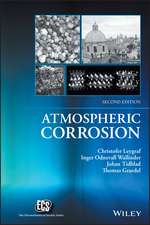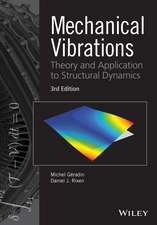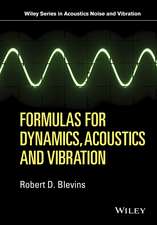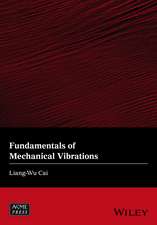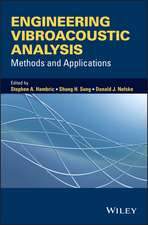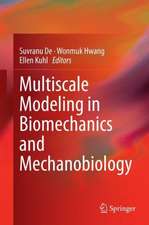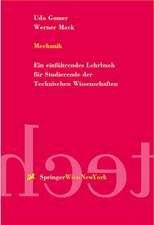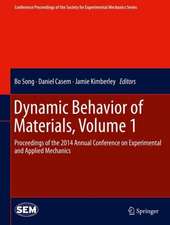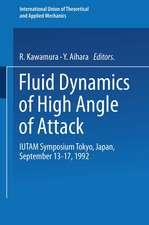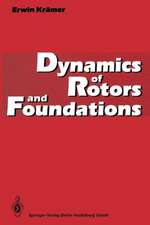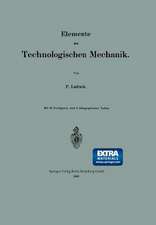Meshless Methods in Solid Mechanics
Autor Youping Chen, James Lee, Azim Eskandarianen Limba Engleză Hardback – 28 apr 2006
| Toate formatele și edițiile | Preț | Express |
|---|---|---|
| Paperback (1) | 383.33 lei 6-8 săpt. | |
| Springer – 29 oct 2010 | 383.33 lei 6-8 săpt. | |
| Hardback (1) | 389.31 lei 6-8 săpt. | |
| Springer – 28 apr 2006 | 389.31 lei 6-8 săpt. |
Preț: 389.31 lei
Nou
Puncte Express: 584
Preț estimativ în valută:
74.52€ • 80.97$ • 62.64£
74.52€ • 80.97$ • 62.64£
Carte tipărită la comandă
Livrare economică 21 aprilie-05 mai
Preluare comenzi: 021 569.72.76
Specificații
ISBN-13: 9780387307367
ISBN-10: 0387307362
Pagini: 200
Ilustrații: XII, 200 p. 60 illus.
Dimensiuni: 155 x 235 x 15 mm
Greutate: 0.45 kg
Ediția:2006
Editura: Springer
Colecția Springer
Locul publicării:New York, NY, United States
ISBN-10: 0387307362
Pagini: 200
Ilustrații: XII, 200 p. 60 illus.
Dimensiuni: 155 x 235 x 15 mm
Greutate: 0.45 kg
Ediția:2006
Editura: Springer
Colecția Springer
Locul publicării:New York, NY, United States
Public țintă
GraduateCuprins
Introduction.- Fundamentals of Continuum Mechanics.- Integral Formulation of Continuum Problems.- Basic Concepts of Finite Element Methods.- An Overview of Meshless Methods.- Procedures of Meshless Analysis.- Meshless Analysis of Elastostatics.- Meshless Analysis of Elastodynamics.- Meshless Analysis of Nonlocal Continua.- Meshless Analysis of Plasticity.- Appendix A Vector and Tensor.- Appendix B Representations of Isotropic Scalar, Vector and Tensor Functions.- Appendix C Classification of Partial Differential Equations.- Appendix D Summary of the Procedures of Direct Integration Methods.- Appendix E User’s Manual of Meshless Programs.- Bibliography.- Index.
Recenzii
From the reviews:
"The book can be considered as a textbook for graduate courses on numerical analysis in solid mechanics. It can also be used as a reference book for engineers and scientists who explore the physical world through computer simulations." (Ján Sládek, Zentralblatt MATH, Vol. 1106 (8), 2007)
"The book can be considered as a textbook for graduate courses on numerical analysis in solid mechanics. It can also be used as a reference book for engineers and scientists who explore the physical world through computer simulations." (Ján Sládek, Zentralblatt MATH, Vol. 1106 (8), 2007)
Notă biografică
Professor James D. Lee earned his Ph.D from Princeton University in 1971 and has been teaching and/or doing research in universities (Purdue U., West Virginia U., U. of Akron, U. of Minnesota and GWU), industry (The General Tire and Rubber Company), and US government laboratories (NIST and NASA). His research has included liquid crystals, fracture mechanics, composite materials, numerical analyses, control, robotics, metal forming process, finite element methods, meshless methods, atomistic and micro-continuum physics. He has directed eight doctoral dissertations and several master theses, and has published more than 100 technical papers including 50 referred journal articles. He is a registered Professional Engineer in Washington, DC and a member of ASME, American Academy of Mechanics, New York Academy of Science, and Sigma Xi.
Dr. Youping Chen is a senior research scientist at the School of Engineering and Applied Science of GWU. She is currently contributing to two major research centers within GWU: The Center for Intelligent Systems Research in smart materials and the FHWA/NHTSA National Crash Analysis Center in computational mechanics. She has over 13 years of experience in engineering mechanics and structural dynamics. Her research experience includes modeling and simulating high-speed railway system, thermoplastic analysis of high-speed impact, meshless methods, atomistic physics and continuum mechanics. She has been conducting advanced research at NCAC on meshless and optimization methods for structures under impact loading. Dr. Chen is currently extending the atomistic physics and continuum mechanics theory in modeling of electromechanical and smart materials. She received a M.S. degree in Engineering Mechanics from Huazhong University of Science and Technology, China in 1991 and D.Sc. degree in Mechanical Engineering from The George Washington University in 2002.
Professor Azim Eskandarianwas the co-founder (in 1992) and the Director of the FHWA/NHTSA National Crash Analysis Center from 1998-2003, where he conducted extensive research in impact dynamics for crashworthiness of structures/materials. He has conducted research in optimization of structures under impact. This research required exploring meshless methods as a better alternative to non-linear explicit dynamic finite element methods due to reshaping of the structures, contact algorithms, and various complexities of impact phenomena. This research is continuing and has lead to the development of draft manuscript for the proposed book addressing the advantages and critical issues of meshless methods in Solid mechanics. Prof. Eskandarian has twenty-one years of experience in engineering R&D, six years in industry and fifteen years in academia. Dr. Eskandarian is the founding Director of the Center for Intelligent Systems Research which focuses in smart materials/systems and intelligent methods in transportation and automotive applications. He has been Principal Investigator and Co-principal Investigator of over $18.6 million of sponsored research anddirected research groups of more than fifty, including faculty, staff, and students. He has published over 100 technical journal and conference papers. He is a member of ASME, ASCE, SAE, Sigma Xi, Tau Beta Pi, Pi Tau Sigma, and serves on several professional committees. Prof. Eskandarian earned his doctoral and Masters and bachleros degrees in Mechanical engineering in 1991, 1983, and 1982 from George Washington University (Washington, DC), Virginia Polytechnique Institute and State University (Blacksburg , VA) and GWU, respectively.
Dr. Youping Chen is a senior research scientist at the School of Engineering and Applied Science of GWU. She is currently contributing to two major research centers within GWU: The Center for Intelligent Systems Research in smart materials and the FHWA/NHTSA National Crash Analysis Center in computational mechanics. She has over 13 years of experience in engineering mechanics and structural dynamics. Her research experience includes modeling and simulating high-speed railway system, thermoplastic analysis of high-speed impact, meshless methods, atomistic physics and continuum mechanics. She has been conducting advanced research at NCAC on meshless and optimization methods for structures under impact loading. Dr. Chen is currently extending the atomistic physics and continuum mechanics theory in modeling of electromechanical and smart materials. She received a M.S. degree in Engineering Mechanics from Huazhong University of Science and Technology, China in 1991 and D.Sc. degree in Mechanical Engineering from The George Washington University in 2002.
Professor Azim Eskandarianwas the co-founder (in 1992) and the Director of the FHWA/NHTSA National Crash Analysis Center from 1998-2003, where he conducted extensive research in impact dynamics for crashworthiness of structures/materials. He has conducted research in optimization of structures under impact. This research required exploring meshless methods as a better alternative to non-linear explicit dynamic finite element methods due to reshaping of the structures, contact algorithms, and various complexities of impact phenomena. This research is continuing and has lead to the development of draft manuscript for the proposed book addressing the advantages and critical issues of meshless methods in Solid mechanics. Prof. Eskandarian has twenty-one years of experience in engineering R&D, six years in industry and fifteen years in academia. Dr. Eskandarian is the founding Director of the Center for Intelligent Systems Research which focuses in smart materials/systems and intelligent methods in transportation and automotive applications. He has been Principal Investigator and Co-principal Investigator of over $18.6 million of sponsored research anddirected research groups of more than fifty, including faculty, staff, and students. He has published over 100 technical journal and conference papers. He is a member of ASME, ASCE, SAE, Sigma Xi, Tau Beta Pi, Pi Tau Sigma, and serves on several professional committees. Prof. Eskandarian earned his doctoral and Masters and bachleros degrees in Mechanical engineering in 1991, 1983, and 1982 from George Washington University (Washington, DC), Virginia Polytechnique Institute and State University (Blacksburg , VA) and GWU, respectively.
Textul de pe ultima copertă
Finite element method has been the dominant technique in computational mechanics in the past decades, and it has made significant contributions to the developments in engineering and science. Nevertheless, finite element method is not well suited to problems having severe mesh distortion owing to extremely large deformations of materials, encountering moving discontinuities such as crack propagation along arbitrary and complex paths, involving considerable meshing and re-meshing in structural optimization problems, or having multidomain of influence in multi-phenomenon physical problems. It is impossible to completely overcome those mesh-related difficulties by a mesh-based method. The highly structured nature of finite element approximations imposes severe penalties in the solutions of those problems.
Distinguishing with finite element, finite difference and finite volume methods, meshless method discretizes the continuum body only with a set of nodal points and the approximation is constructed entirely in terms of nodes. There is no need of mesh or elements in this method. It does not posses the mesh related difficulties, eliminates at least part of the FE structure, and provides an approach with more flexibility in the applications in engineering and science.
The meshless method started to capture the interest of a broader community of researchers only several years ago, and now it becomes a growing and evolving field. It is showing that this is a very rich area to be explored, and has great promise for many very challenging computational problems. On the one hand, great developments on meshless methods have been achieved. On the other hand, there are many aspects of meshless methods that could be benefit from improvements. A broader community of researchers can bring divergent skills and backgrounds to bear on the task of improving this method.
The main objective of this book is to provide a textbook for graduate courses on the computational analysis of continuum and solid mechanics based on meshless (also known as mesh free) methods. It can also be used as a reference book for engineers and scientists who are exploring the physical world through computer simulations. Emphasis of this book is given to the understanding of the physical and mathematical characteristics of the procedures of computational solid mechanics. It naturally brings the essence, advantages and challenging problems of meshless methods into the picture.
The subjects in this book cover the fundamentals of continuum mechanics, the integral formulation methods of continuum problems, the basic concepts of finite element methods, and the methodologies, formulations, procedures, and applications of various meshless methods. It also provides general and detailed procedures of meshless analysis on elastostatics, elastodynamics, non-local continuum mechanics and plasticity with a large number of numerical examples. Some basic and important mathematical methods are included in the Appendixes. For the readers who want to gain knowledge through hands-on experience, the meshless programs for elastostatics and elastodynamics are also introduced in the book and included in the disc.
Distinguishing with finite element, finite difference and finite volume methods, meshless method discretizes the continuum body only with a set of nodal points and the approximation is constructed entirely in terms of nodes. There is no need of mesh or elements in this method. It does not posses the mesh related difficulties, eliminates at least part of the FE structure, and provides an approach with more flexibility in the applications in engineering and science.
The meshless method started to capture the interest of a broader community of researchers only several years ago, and now it becomes a growing and evolving field. It is showing that this is a very rich area to be explored, and has great promise for many very challenging computational problems. On the one hand, great developments on meshless methods have been achieved. On the other hand, there are many aspects of meshless methods that could be benefit from improvements. A broader community of researchers can bring divergent skills and backgrounds to bear on the task of improving this method.
The main objective of this book is to provide a textbook for graduate courses on the computational analysis of continuum and solid mechanics based on meshless (also known as mesh free) methods. It can also be used as a reference book for engineers and scientists who are exploring the physical world through computer simulations. Emphasis of this book is given to the understanding of the physical and mathematical characteristics of the procedures of computational solid mechanics. It naturally brings the essence, advantages and challenging problems of meshless methods into the picture.
The subjects in this book cover the fundamentals of continuum mechanics, the integral formulation methods of continuum problems, the basic concepts of finite element methods, and the methodologies, formulations, procedures, and applications of various meshless methods. It also provides general and detailed procedures of meshless analysis on elastostatics, elastodynamics, non-local continuum mechanics and plasticity with a large number of numerical examples. Some basic and important mathematical methods are included in the Appendixes. For the readers who want to gain knowledge through hands-on experience, the meshless programs for elastostatics and elastodynamics are also introduced in the book and included in the disc.
Caracteristici
An essential source and reference for understanding meshless methods and the procedures for implementing the techniques to solve real engineering problems Provides a textbook for graduate students, researchers/engineers and scientists interested in both fundamentals and the latest developments in the field A full Solutions Manual and PowerPoint presentations are available to instructors Includes supplementary material: sn.pub/extras





